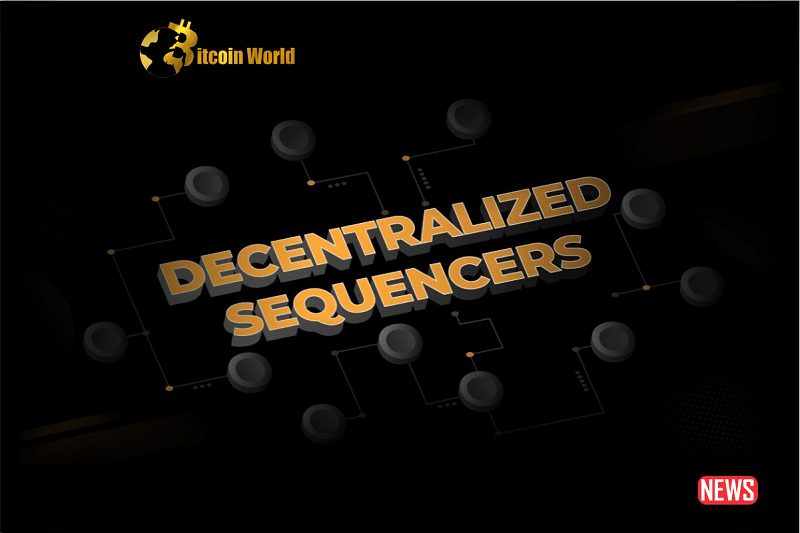Ever felt the frustration of slow transaction speeds and high fees on Ethereum? Rollup networks are a promising solution, designed to significantly boost Ethereum’s transaction throughput. But there’s a critical component under the hood that often goes unnoticed: the sequencer. Think of it as the traffic controller for a rollup network, ensuring everything runs smoothly. However, relying on a single traffic controller? That’s a potential bottleneck, and that’s where decentralized sequencers come into play. Let’s dive into why they’re so crucial for the future of Ethereum’s scalability.
Why Sequencers Matter: The Engine Room of Rollups
Existing rollup technologies, like ZK-rollups and optimistic rollups, have already made strides in improving scalability. But they aren’t without their quirks. ZK-rollups, while incredibly secure, can be computationally intensive. Optimistic rollups, on the other hand, face challenges related to transaction reversibility and Miner Extractable Value (MEV). This is where sequencers step in to refine the process.
Here’s how sequencers supercharge rollup networks:
- Transaction Ordering: Sequencers organize incoming transactions according to predefined rules, minimizing conflicts and optimizing processing. Imagine a well-organized assembly line versus a chaotic free-for-all.
- Batching Transactions: They bundle multiple transactions into a single, more efficient transaction that’s then posted to the main Ethereum chain. This significantly reduces on-chain gas costs. Think of it as sending one large package instead of many individual letters.
- Increased Throughput: By streamlining the transaction process, sequencers dramatically increase the number of transactions a rollup network can handle.
The Achilles’ Heel: The Problem with Centralized Sequencers
While convenient and often cost-effective initially, relying on a single, centralized sequencer presents significant risks. Imagine if that single traffic controller went offline – the entire network grinds to a halt! Here’s a closer look at the downsides:
- Censorship Vulnerability: A centralized sequencer can choose to exclude certain transactions, effectively censoring users.
- Potential for High Fees: A single sequencer has the power to inflate transaction fees.
- MEV Exploitation: A malicious sequencer could reorder or insert transactions to extract maximum value (MEV) at the expense of users.
- Single Point of Failure: As mentioned earlier, if the centralized sequencer fails, the entire rollup network becomes unusable.
The Path to Decentralization: Building a More Robust Future
So, how do we overcome these limitations? The answer lies in decentralization. Distributing the responsibilities of the sequencer across multiple entities creates a more resilient and trustworthy network. Several approaches are being explored:
- Proof-of-Authority (PoA): A select group of reputable entities are chosen to operate sequencers. This enhances censorship resistance compared to a single sequencer but still carries some risk of single points of failure within the authorized group.
- Based Rollups: This approach allows anyone to act as a sequencer. While highly decentralized, it introduces challenges like potential revenue leakage and vulnerability to MEV attacks as different sequencers might compete to process the same transactions.
- Distributed Validator Technology (DVT): Sequencer responsibilities are spread across multiple nodes, similar to how validators work on the Ethereum mainnet. This offers flexibility and improved fault tolerance but can introduce some latency due to the coordination required between nodes.
- Shared Sequencing: Multiple rollups share a single, decentralized sequencer network. This offers exciting possibilities for cross-chain atomic transactions (where transactions across different rollups are guaranteed to either both succeed or both fail) and provides strong, real-time censorship resistance.
| Approach | Pros | Cons |
|---|---|---|
| Proof-of-Authority (PoA) | Improved censorship resistance over centralized sequencers | Still potential for single points of failure within the authorized group |
| Based Rollups | Highly decentralized | Proceeds leakage, potential for MEV attacks |
| Distributed Validator Technology (DVT) | Flexible, improved fault tolerance | Potential for increased latency |
| Shared Sequencing | Cross-chain atomicity, strong censorship resistance | Complexity in implementation |
What Opportunities Lie Ahead?
The development of decentralized sequencers is opening up exciting new avenues for innovation and investment. Consider these potential opportunities:
- Sequencer Service Providers: Businesses specializing in running and maintaining decentralized sequencer infrastructure.
- Security Auditors: Experts needed to ensure the security and robustness of decentralized sequencer networks.
- Cross-Chain Solution Providers: Developing tools and infrastructure to facilitate seamless interaction between rollups using shared sequencers.
The Future is Decentralized: A More Scalable and Secure Ethereum
The evolution of decentralized sequencing is being driven by several key factors:
- The Need for Multi-Chain Interoperability: Seamless communication and transaction execution across different blockchain networks is becoming increasingly important.
- Stronger MEV Prevention: Protecting users from predatory MEV extraction is a crucial goal.
- Enhanced User Protection: Decentralization offers greater transparency and control for users.
- Improved Governance and Participation: Decentralized systems can foster more inclusive and community-driven governance models.
These advancements will pave the way for innovative business models and drive the widespread adoption of decentralized sequencers, ultimately contributing to a more robust and scalable Ethereum ecosystem.
In Conclusion: Embracing the Decentralized Revolution
Decentralized sequencers are not just a technical upgrade; they represent a fundamental shift towards a more secure, censorship-resistant, and scalable future for Ethereum. As the technology matures, we can anticipate further breakthroughs in multi-chain interoperability, MEV mitigation, and governance mechanisms. Keep an eye on this space – decentralized sequencers are a crucial piece of the puzzle in unlocking the full potential of blockchain technology and building a truly decentralized web.
Disclaimer: The information provided is not trading advice, Bitcoinworld.co.in holds no liability for any investments made based on the information provided on this page. We strongly recommend independent research and/or consultation with a qualified professional before making any investment decisions.


